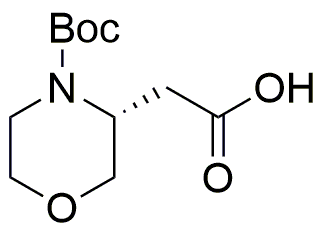(R)-4-Boc-3-morpholineacetic acid is widely utilized in research focused on:
- Synthetic Chemistry: This compound serves as an important building block in the synthesis of various pharmaceuticals, enabling researchers to create complex molecules efficiently.
- Drug Development: Its unique structure allows for the development of new drug candidates, particularly in the field of central nervous system disorders, where it may enhance bioavailability and efficacy.
- Peptide Synthesis: The compound is used in the preparation of peptide derivatives, which are crucial for developing therapeutic agents and vaccines.
- Biochemical Research: It acts as a useful reagent in studying enzyme mechanisms and protein interactions, helping researchers understand biological processes at a molecular level.
- Material Science: The compound can be incorporated into polymer formulations, improving the properties of materials used in coatings and adhesives.
General Information
Properties
Safety and Regulations
Applications
(R)-4-Boc-3-morpholineacetic acid is widely utilized in research focused on:
- Synthetic Chemistry: This compound serves as an important building block in the synthesis of various pharmaceuticals, enabling researchers to create complex molecules efficiently.
- Drug Development: Its unique structure allows for the development of new drug candidates, particularly in the field of central nervous system disorders, where it may enhance bioavailability and efficacy.
- Peptide Synthesis: The compound is used in the preparation of peptide derivatives, which are crucial for developing therapeutic agents and vaccines.
- Biochemical Research: It acts as a useful reagent in studying enzyme mechanisms and protein interactions, helping researchers understand biological processes at a molecular level.
- Material Science: The compound can be incorporated into polymer formulations, improving the properties of materials used in coatings and adhesives.
Documents
Safety Data Sheets (SDS)
The SDS provides comprehensive safety information on handling, storage, and disposal of the product.
Product Specification (PS)
The PS provides a comprehensive breakdown of the product’s properties, including chemical composition, physical state, purity, and storage requirements. It also details acceptable quality ranges and the product's intended applications.
Certificates of Analysis (COA)
Search for Certificates of Analysis (COA) by entering the products Lot Number. Lot and Batch Numbers can be found on a product’s label following the words ‘Lot’ or ‘Batch’.
Numéro de catalogue
Numéro de lot/série
Certificates Of Origin (COO)
This COO confirms the country where the product was manufactured, and also details the materials and components used in it and whether it is derived from natural, synthetic, or other specific sources. This certificate may be required for customs, trade, and regulatory compliance.
Numéro de catalogue
Numéro de lot/série
Safety Data Sheets (SDS)
The SDS provides comprehensive safety information on handling, storage, and disposal of the product.
DownloadProduct Specification (PS)
The PS provides a comprehensive breakdown of the product’s properties, including chemical composition, physical state, purity, and storage requirements. It also details acceptable quality ranges and the product's intended applications.
DownloadCertificates of Analysis (COA)
Search for Certificates of Analysis (COA) by entering the products Lot Number. Lot and Batch Numbers can be found on a product’s label following the words ‘Lot’ or ‘Batch’.
Numéro de catalogue
Numéro de lot/série
Certificates Of Origin (COO)
This COO confirms the country where the product was manufactured, and also details the materials and components used in it and whether it is derived from natural, synthetic, or other specific sources. This certificate may be required for customs, trade, and regulatory compliance.


